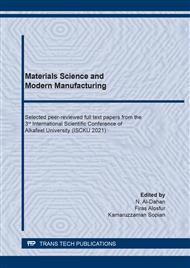[1]
K. Saito, A. Sakuma, and M. Fukuda, Recent life assessment technology for existing steam turbines,, 11th Int. Conf. Fract. 2005, ICF11, vol. 4, p.3167–3172, (2005).
DOI: 10.1115/pwr2005-50345
Google Scholar
[2]
D. Ziegler, M. Puccinelli, B. Bergallo, and A. Picasso, Investigation of turbine blade failure in a thermal power plant,, Case Stud. Eng. Fail. Anal., vol. 1, no. 3, p.192–199, 2013,.
DOI: 10.1016/j.csefa.2013.07.002
Google Scholar
[3]
O. Jonas and L. Machemer, STEAM TURBINE CORROSION AND DEPOSITS PROBLEMS AND SOLUTIONS by,, (1983).
Google Scholar
[4]
A. A. Ugla, M. I. Hasan, Z. A. Ibrahim, D. J. Kamil, and H. J. Khudair, Effects of Nano Coating on the Mechanical Properties of Turbine Blades : A Review,, vol. 44, no. 4, p.134–144, (2021).
Google Scholar
[5]
E. Kosieniak, K. Biesiada, J. Kaczorowski, and M. Innocenti, Corrosion Failures in Gas Turbine Hot Components,, p.330–337, 2012,.
DOI: 10.1007/s11668-012-9571-3
Google Scholar
[6]
G. W. Goward, Progress in coatings for gas turbine airfoils,, vol. 109, p.73–79, (1998).
DOI: 10.1016/s0257-8972(98)00667-7
Google Scholar
[7]
R. A. Rapp and Y. S. Zhang, Hot Corrosion of Materials : Fundamental Studies,, p.47–55.
Google Scholar
[8]
M. Bogdan and D. Zasada, Józef Błachnio Mariusz Bogdan Dariusz Zasada Increased temperature impact on durability of gas turbine blades Wpływ podwyższonej temperatury na trwałość łopatek turbiny gazowej *,, vol. 19, no. 1, p.48–53, (2017).
DOI: 10.17531/ein.2017.1.7
Google Scholar
[9]
N. Asok Kumar and S. R. Kale, Numerical simulation of steady state heat transfer in a ceramic-coated gas turbine blade,, Int. J. Heat Mass Transf., vol. 45, no. 24, p.4831–4845, 2002,.
DOI: 10.1016/s0017-9310(02)00190-4
Google Scholar
[10]
Y. Gao, J. Gao, and D. Yang, Equiaxed and porous thermal barrier coatings deposited by atmospheric plasma spray using a nanoparticles powder,, Adv. Eng. Mater., vol. 16, no. 4, p.406–412, 2014,.
DOI: 10.1002/adem.201300284
Google Scholar
[11]
Y. Fedorova et al., NU SC,, Surf. Coat. Technol., 2015,.
Google Scholar
[12]
J. H. Liu, Y. B. Liu, X. He, and L. Liu, Study on TBCs insulation characteristics of a turbine blade under serving conditions,, Case Stud. Therm. Eng., vol. 8, p.250–259, 2016,.
DOI: 10.1016/j.csite.2016.08.004
Google Scholar
[13]
A. C. Joshi, A. L. Rufus, S. Suresh, P. Chandramohan, S. Rangarajan, and S. Velmurugan, Characterization of the oxide formed in the presence of poly acrylic acid over the steam generator structural materials of nuclear power plants,, J. Nucl. Mater., vol. 437, no. 1–3, p.139–148, 2013,.
DOI: 10.1016/j.jnucmat.2013.01.353
Google Scholar
[14]
N. Gat and O. Systems, DocuServe,, no. July 1980, 2016,.
Google Scholar
[15]
A. Hamed, Temperature Effect on Particle Dynamics and Erosion in Radial,, vol. 110, no. April 1988, (2017).
Google Scholar
[16]
V. Shanov, W. Tabakoff, and R. N. Singh, CVD Diamond Coating for Erosion Protection at Elevated Temperatures,, vol. 11, no. April, p.220–225, (2002).
DOI: 10.1361/105994902770344303
Google Scholar
[17]
J. A. R. Babu, K. K. Kumar, and S. S. Rao, State-of-art review on hybrid nanofluids State-of-art review on hybrid nano fl uids,, Renew. Sustain. Energy Rev., vol. 77, no. October, p.551–565, 2017, [Online]. Available: http://dx.doi.org/10.1016/j.rser.2017.04.040.
DOI: 10.1016/j.rser.2017.04.040
Google Scholar
[18]
M. Liu, M. C. Lin, I. Huang, and C. Wang, Enhancement of thermal conductivity with carbon nanotube for nanofluids B,, vol. 32, p.1202–1210, 2005,.
Google Scholar
[19]
N. A. Che Sidik, I. M. Adamu, and M. Mahmud Jamil, Preparation Methods and Thermal Performance of Hybrid Nanofluids,, J. Adv. Res. Appl. Mech., vol. 66, no. 1, p.7–16, 2020,.
DOI: 10.37934/aram.66.1.716
Google Scholar
[20]
W. Yu and H. Xie, A review on nanofluids: Preparation, stability mechanisms, and applications,, J. Nanomater., vol. 2012, 2012,.
Google Scholar
[21]
K. A. S. Al-saadie and H. A. Y. Al-mashhdani, Corrosion Protection Study for Caron Steel in Seawater by Coating with SiC and ZrO 2 Nanoparticles,, vol. 5, no. 1, p.28–39, 2015,.
Google Scholar


